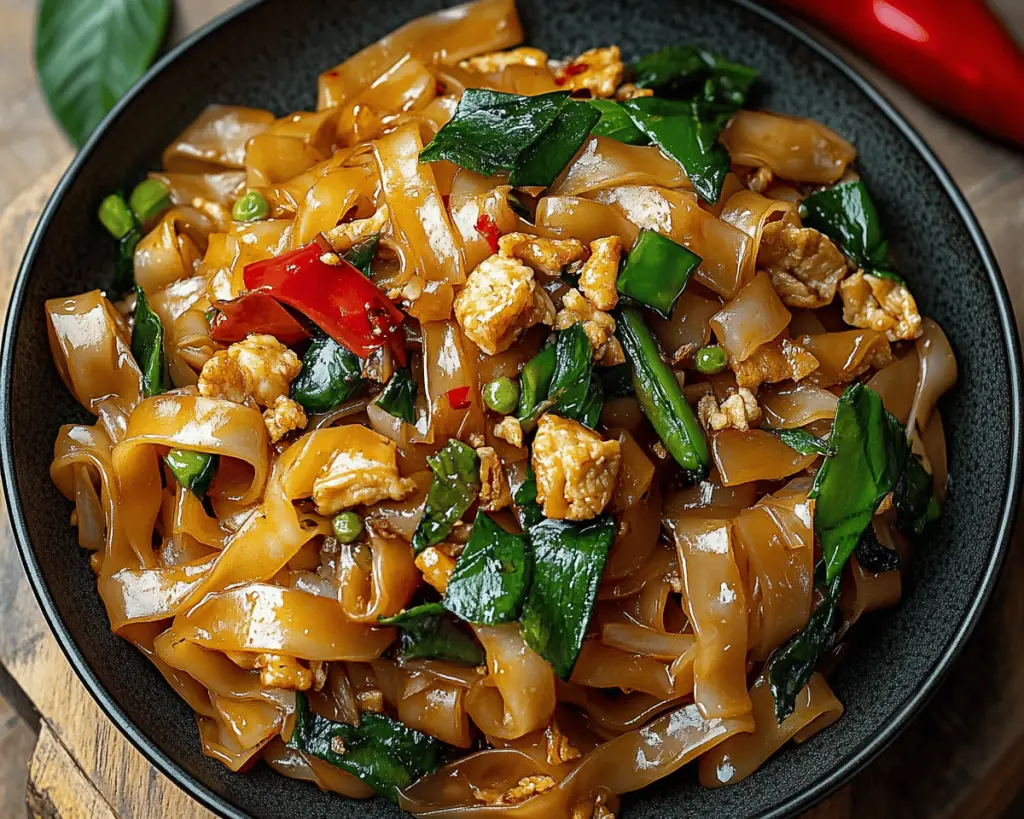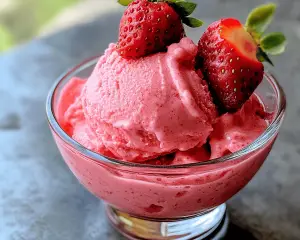It was a sultry summer evening when I first encountered the enticing aroma of Thai Drunken Noodles, or Pad Kee Mao as it’s known in Thailand. A close friend, Mae, had invited me to her home in the heart of the city for a casual get-together. As we mingled, laughter swirling in the warm air, Mae’s small kitchen transformed into a cauldron of fragrances that danced all around us. At that moment, I had little idea of how profoundly this dish would weave itself into the fabric of my life.
Mae was a culinary artist, crafting dishes that told stories of her family, of her roots in Thailand. Her Drunken Noodles turned out to be a masterpiece – each strand of rice noodle coated in a luscious, spicy sauce, intermingling with vibrant veggies, aromatic basil, and slices of tender meat. It wasn’t just a dinner; it was an experience. Mae, in her gentle and playful way, explained that this dish was traditionally enjoyed by those out on the town, sharing late-night banter over a few drinks. And as we dug into the colorful medley, I understood why it had earned that reputation. It was indulgent but welcoming, every bite brimming with the kind of warmth that makes you reminisce about the most comfortable aspects of home.
As summer dripped into fall, I found myself adrift in an ocean of responsibilities, with work deadlines crashing in on one another and personal commitments pulling me in all directions. I needed an anchor, something to ground my swirling thoughts. So, I turned to the Drunken Noodles recipe Mae had shared with me that night. I whipped it up in my own little kitchen, the rhythmic movements of slicing, stirring, and tossing bringing back those cherished memories. As the steam rose and the familiar scents enveloped me, something inside shifted. This dish became my late-night solace.
With each bowl I prepared, I discovered little nuances: the precise balance of soy sauce and the playful kick of chili added just the right amount of fire, metaphorically and literally. I started slipping in seasonal veggies—broccoli or carrots as autumn settled in; the flavors blended beautifully with the noodles, creating an ever-changing canvas of color and taste that mirrored the progress of the seasons in my life. Drunken Noodles became my comfort food, my secret weapon against the slow creep of anxiety on long days.
Inside the Ingredients of Thai Drunken Noodles
Let’s dive into the heart of this dish – the ingredients that harmoniously work together to create a memorable experience.
Rice Noodles: The backbone of this dish. Soft yet chewy, they absorb flavors beautifully and provide a satisfying texture. Typically, you’ll want the flat rice noodles, often labeled as “bihun” or “sen yai.” Cooking them is an art; overcooked, they turn mushy, and undercooked, they remain hard. I’ve learned the hard way that timing is everything — they should still have that lovely al dente bite when combined with the sauce.
Vegetables: This dish is so versatile that you can include any vegetable that catches your eye! Traditionally, bell peppers, broccoli, and carrots are used, but I love throwing in a handful of snap peas for that sweet crunch or baby corn for a nostalgic nod to my childhood. The color and crunch contrast beautifully against the noodles, making each bite a delightful surprise.
Protein: You can choose your own adventure here – whether it’s chicken, shrimp, or tofu for a plant-based option. The protein absorbs the savory sauce’s richness, making it deeply satisfying. Personally, I have a soft spot for shrimp; their sweetness pairs so well with the spicy sauce.
Holy Basil: This is an essential player in the dish. Different from the sweet basil often found in supermarkets, holy basil has a peppery, slightly spicy flavor that transcends the ordinary. If you can find it at an Asian grocery store, grab a bunch; it’ll elevate your dish to new heights.
Soy Sauce: This ingredient is the umami anchor for the dish. Balancing the saltiness alongside the sweetness of the sugar is crucial. I remember my first attempt at flavoring the dish led to an overly salty outcome, a rookie mistake where I got too enthusiastic and poured too much in!
Fish Sauce: This pungent, fermented liquid is the soul of Thai cooking. It adds depth to the dish and balances the overtly sweet flavors. Just a spoonful or two can transform the overall profile, adding a complexity that brings warmth to the meal.
Chilies: Fresh or dried, they are the element of excitement in Drunken Noodles. I’ve learned to embrace the fiery spice—just enough to tantalize without overpowering the dish. On one occasion, I misjudged and added a few too many fresh Thai bird chilies. Let’s just say, there was water, and there was a desperate attempt to balance the dish with extra noodles. True champion-level scrambling in the kitchen that evening!
How Thai Drunken Noodles Fits Into a Balanced Life
In our fast-paced world, finding balance is often easier said than done. As I perfected my Drunken Noodles, I realized they elegantly bridged the gap between enjoyment and health.
Nutritionally, you can tailor this dish to meet various dietary preferences. Using lots of vegetables, the dish stands tall on its own as a hefty meal. I appreciate how the vibrant colors translate to a visual feast, making me want to dive in every single time.
And let’s kid ourselves; indulgence is a part of a balanced life too, right? There’s joy in creating something that sings to your soul. Once, during a particularly hectic week, I made this dish for a group of friends as a small gathering. We laughed, we reminisced, we clinked our glasses, all while devouring heaping platters of those noodles. It’s moments like these that make you feel whole.
For those who might need to watch their carbohydrate intake, this dish adapts readily to gluten-free noodles or even spiralized veggies. I’ve taken to using zucchini or sweet potato noodles with great success, though they require a bit of finesse with cooking times. Don’t shy away from experimenting—you just may stumble upon your new favorite version.
What I’ve learned through my love for Drunken Noodles is the beauty of forgiveness—when my sauce turns out too salty or my noodles overcooked, I simply relish in the experience and the flavors. Each mishap in the kitchen is a lesson, and I’ve embraced that.
What You’ll Need
– 8 oz rice noodles
– 2 cups mixed vegetables (bell peppers, broccoli, carrots)
– 1 lb protein (chicken, shrimp, or tofu)
– 1 cup holy basil leaves
– 3 tablespoons soy sauce
– 1 tablespoon fish sauce
– 1 tablespoon sugar
– 2-3 bird chilies (adjust according to heat preference)
– 2 cloves garlic, minced
– 2 tablespoons vegetable oil
This will serve about 3-4 people, perfect for a cozy gathering or a meal that lasts a few days.
Preparing Thai Drunken Noodles Step by Step
Here’s where the magic happens. Find a pocket of time—put on some music, set the mood, and let’s dive into the joyous chaos of cooking.
Start by soaking your rice noodles in hot water for about 10–15 minutes until they’re tender but still have a bite. Remember, you want them to be alive, not slumped over! Rinse them with cold water and drain—this stops the cooking process.
Now, while your noodles soak, take a moment to prep your vegetables and protein. Slice everything to size—uniform pieces make for even cooking. The kitchen should start humming with anticipation at this point.
Next, heat your vegetable oil in a large pan or wok over medium-high heat. Add the minced garlic and diced protein of your choice. Once the protein is golden brown, toss in your beautifully chopped vegetables; they should sizzle immediately and release that enticing aroma.
Now comes the fun part: add the rinsed noodles to the pan! With a spatula, gently fold the noodles in with the other ingredients, trying not to break them. They’re delicate yet resilient, much like the stories woven through our lives.
Pour in the soy sauce, fish sauce, and sugar. As you mix everything, your kitchen will erupt with enticing flavors and laughter—they’re part of the symphony being created.
This is where you also add in the chopped bird chilies. Whether they’re fresh or dried, embrace the heat!
Lastly, after everything is well-combined and heated through, fold in those fragrant holy basil leaves. Let them wilt just enough to release their oils—it’s magical how the scent fills the air at this moment.
Transfer your creation to bowls and take a moment. Step back and appreciate the colors, the aromas, and the love that went into it. Maybe even snap a photo; these moments deserve to be cherished.
Lessons from My Kitchen
Along this culinary journey, I’ve faced my share of setbacks and triumphant moments. One particularly memorable instance was when I miscalculated the time my noodles needed to soak. They turned mushy and stuck together, becoming an unappetizing mass. But then, a revelation struck: I threw in a can of coconut milk and turned it into a creamy Thai noodle soup! Sometimes, the messes clear a path to something extraordinary.
Friends often ask me, “What’s the secret to your Drunken Noodles?” And while there’s a solid base recipe, the real magic lies in the joy of improvisation. I’ve included seasonal vegetables, swapped out proteins depending on what was available, and tried it with gluten-free options. Each reinterpretation tells a different story, and I feel liberated by that.
Quotes from Mae often play in my mind as I cook, reminding me that food is about connection, experience, and celebration—that it deserves to be shared and enjoyed.
My notes are littered with variations: add more chili for that fiery summer night, or tone it down for a cozy family gathering. I’ve learned to embrace the randomness of cooking and let the ingredients speak for themselves.
In the orchestra of preparing Drunken Noodles, we have the opportunity to compose our own melodies. Every time I approach that stovetop, I’m there to create not just a meal, but a moment that deserves to be relished.
(Closing Thought)
As I sit here reflecting on my journey with Thai Drunken Noodles, it strikes me how deeply they have become intertwined with my own story. They have endured chaotic times and served as a celebration during moments of joy. I invite you to bring this dish into your life, letting it evolve and unfold as you experience it in your way.
Whether you’re cooking for yourself after a long day or inviting friends over for a shared meal, I hope you find the same warmth and connection that I have come to cherish. Cooking is about transformation — not just of ingredients but of moments that linger long after the meal is over. Embrace the chaos, savor the flavors, and let your own tales unfold around a plate of Drunken Noodles.



